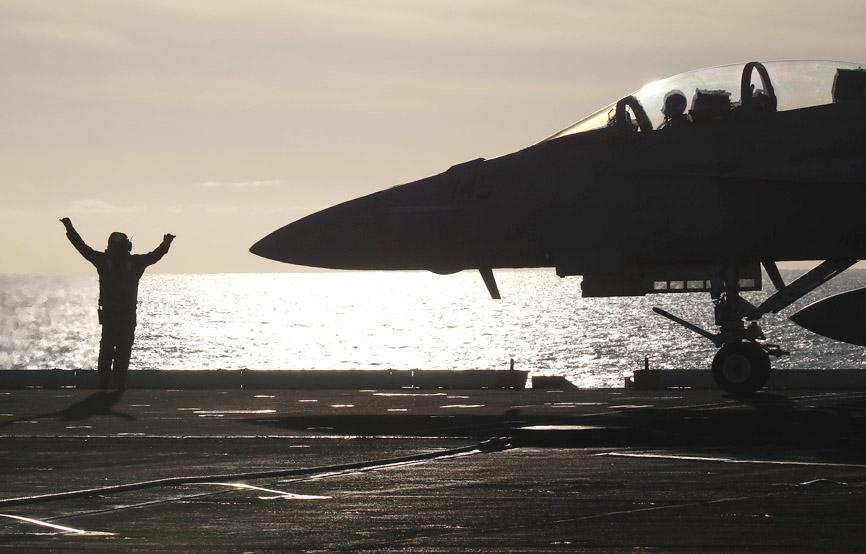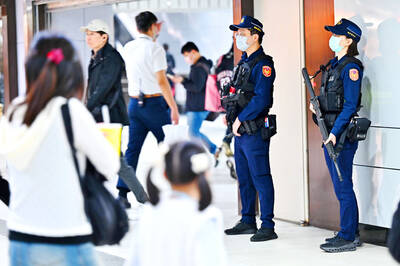Two US aircraft carriers were yesterday conducting exercises in the disputed South China Sea, the US Navy said as China also carried out military drills that have been criticized by the US Department of Defense and neighboring states.
China and the US have accused each other of stoking tension in the waterway at a time of strained relations over everything from COVID-19 to trade to Hong Kong.
The USS Nimitz and USS Ronald Reagan were carrying out operations and exercises in the South China Sea “to support a free and open Indo-Pacific,” the navy said in a statement.

Photo: AFP
It did not say exactly where the exercises were being conducted in the South China Sea, which extends for about 1,500km and 90 percent of which is claimed by China, despite the protests of its neighbors.
Taiwan, Brunei, Malaysia, the Philippines and Vietnam also lay claim to parts of the South China Sea, through which about US$3 trillion of trade passes each year.
“The purpose is to show an unambiguous signal to our partners and allies that we are committed to regional security and stability,” US Rear Admiral George Wikoff was quoted as saying by the Wall Street Journal, which first reported the exercises.
Wikoff, commander of the strike group led by the Ronald Reagan, said the exercises were not a response to those being conducted by China, which the department criticized this week as “counter-productive to efforts at easing tensions and maintaining stability.”
China dismissed the US criticism of its drills on Friday and said the US was to blame for increasing tensions.
US carriers have long carried out exercises in the Western Pacific, including in the South China Sea, according to the US Navy. At one point recently, the US had three carriers in the region.
China last week announced that it had scheduled five days of drills starting on Wednesday near the Paracel Islands (Xisha Islands, 西沙群島), which are claimed by Taiwan, Vietnam and China.
Vietnam and the Philippines have also criticized the Chinese drills, saying that they could create tension in the region and affect Beijing’s relations with its neighbors.
The US has accused China of trying to intimidate neighbors who might want to exploit its extensive oil and gas reserves.
The US statement said the naval exercises gave commanders the flexibility and capabilities “that only the US Navy can command.”
Separately yesterday, Taiwan’s Air Force Command Headquarters reported that a Chinese fighter briefly entered the nation’s airspace, before leaving after radio warnings were issued.
There is no cause for alarm, the air force said, adding that it is closely monitoring the airspace and waters around Taiwan.
Additional reporting by CNA

TRAGEDY STRIKES TAIPEI: The suspect died after falling off a building after he threw smoke grenades into Taipei Main Station and went on a killing spree in Zhongshan A 27-year-old suspect allegedly threw smoke grenades in Taipei Main Station and then proceeded to Zhongshan MRT Station in a random killing spree that resulted in the death of the suspect and two other civilians, and seven injured, including one in critical condition, as of press time last night. The suspect, identified as a man surnamed Chang Wen (張文), allegedly began the attack at Taipei Main Station, the Taipei Fire Department said, adding that it received a report at 5:24pm that smoke grenades had been thrown in the station. One man in his 50s was rushed to hospital after a cardiac arrest

A car bomb killed a senior Russian general in southern Moscow yesterday morning, the latest high-profile army figure to be blown up in a blast that came just hours after Russian and Ukrainian delegates held separate talks in Miami on a plan to end the war. Kyiv has not commented on the incident, but Russian investigators said they were probing whether the blast was “linked” to “Ukrainian special forces.” The attack was similar to other assassinations of generals and pro-war figures that have either been claimed, or are widely believed to have been orchestrated, by Ukraine. Russian Lieutenant General Fanil Sarvarov, 56, head

SAFETY FIRST: Double the number of police were deployed at the Taipei Marathon, while other cities released plans to bolster public event safety Authorities across Taiwan have stepped up security measures ahead of Christmas and New Year events, following a knife and smoke bomb attack in Taipei on Friday that left four people dead and 11 injured. In a bid to prevent potential copycat incidents, police deployments have been expanded for large gatherings, transport hubs, and other crowded public spaces, according to official statements from police and city authorities. Taipei Mayor Chiang Wan-an (蔣萬安) said the city has “comprehensively raised security readiness” in crowded areas, increased police deployments with armed officers, and intensified patrols during weekends and nighttime hours. For large-scale events, security checkpoints and explosives

PUBLIC SAFETY: The premier said that security would be tightened in transport hubs, while President Lai commended the public for their bravery The government is to deploy more police, including rapid response units, in crowded public areas to ensure a swift response to any threats, President William Lai (賴清德) said yesterday after a knife attack killed three people and injured 11 in Taipei the previous day. Lai made the remarks following a briefing by the National Police Agency on the progress of the investigation, saying that the attack underscored the importance of cooperation in public security between the central and local governments. The attack unfolded in the early evening on Friday around Taipei Main Station’s M7 exit and later near the Taipei MRT’s Zhongshan